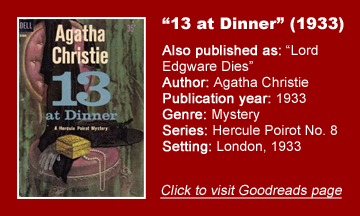“13 at Dinner” (1933) is vintage Agatha Christie, featuring one of those clever solutions that in retrospect makes perfect sense, standing as one of her best early character works, and showcasing classic Poirot-Hastings conversations (with the latter serving as the book’s narrator) as they work out of their shared London flat/office.
An unusual request
The case starts in unusual fashion with actress Jane Wilkinson, a.k.a. Lady Edgware, engaging Poirot not to solve the murder of her husband (this book is also known as “Lord Edgware Dies,” but that event hasn’t happened yet), but rather to try to talk Lord Edgware into divorcing her.
Jane goes on to be one of Christie’s great personalities, an openly amoral sociopath who nonetheless has an innocence about her because she is incapable of grasping morality.
Despite the title (which riffs on a superstition that it’s bad luck to have exactly 13 people at a dinner party), the dinner in question is a small part of the plot.
Numerous suspects
Christie focuses on slightly less than 13 primary players, enough to give us a good array of suspects while also allowing the author to give them distinct personalities and motives for wanting Lord Edgware dead.
The American actress Carlotta Adams is known for her impersonations, including one of Jane, and Christie uses the idea of someone possibly posing as someone else as clues and red herrings. This works wonderfully in literary form, but I wonder how it would play in a visual medium. Apparently quite well, as this novel has been adapted many times.
The beautiful Jane has several suitors, and that might be a motive for wanting Lord Edgware dead. But, if they were rebuffed by Jane, it could also be a motive for framing Jane for her husband’s murder. Plus there’s the incongruous fact that Edgware tells Poirot he is willing to grant Jane a divorce.
Working our little grey cells
Christie has our little grey cells working overtime as we think of motives for various outcomes (not merely Edgware’s death, but also how his death might affect others) and sorting through clues. For example, does the initial “D” on Carlotta’s gifted gold case refer to one of our characters? We start thinking of first names, last names and nicknames.
I was also wondering if a pin that keeps fashionable hats on the sides of women’s heads might be the murder weapon. The author gives enough details about people and their proclivities that we create the red herrings in our minds rather than needing Christie to bluntly serve them up.
I love the explanation for Jane’s mysterious phone call at the dinner party, as well as the full story behind a letter from Carlotta to her sister back in America. On the other hand, Poirot’s tipoff via a random snippet of conversation on the street is highly coincidental – but I’ll give it a pass because overall I was engrossed by Poirot’s “five questions” and the story’s twists and turns.

Thrilling conclusion
“13 at Dinner” is warmly in the category of Poirot-Hastings novels, as Hastings (with Inspector Japp echoing his view) narrates that he’s sure Poirot has lost his mind, but we as readers know Poirot’s order and method – and preference for sitting at home thinking, letting Japp do the legwork – is serving him well.
While I like to think myself cleverer than Hastings and Japp in that I know their prime suspects didn’t do it, I admit that I didn’t solve the case at Poirot’s speed. Naturally, that had me blazing through the last 50 pages until the great detective reveals all.
I rank “13 at Dinner” up there with “The Murder of Roger Ackroyd” and “Hercule Poirot’s Christmas” as a novel where Christie brilliantly defies whodunit conventions. My knee-jerk reaction is to think “She tricked me,” but then I have to admit the author was playing fair all along; like Hastings and Japp, I couldn’t see past my assumptions.
Every week, Sleuthing Sunday reviews an Agatha Christie book or adaptation. Click here to visit our Agatha Christie Zone.


